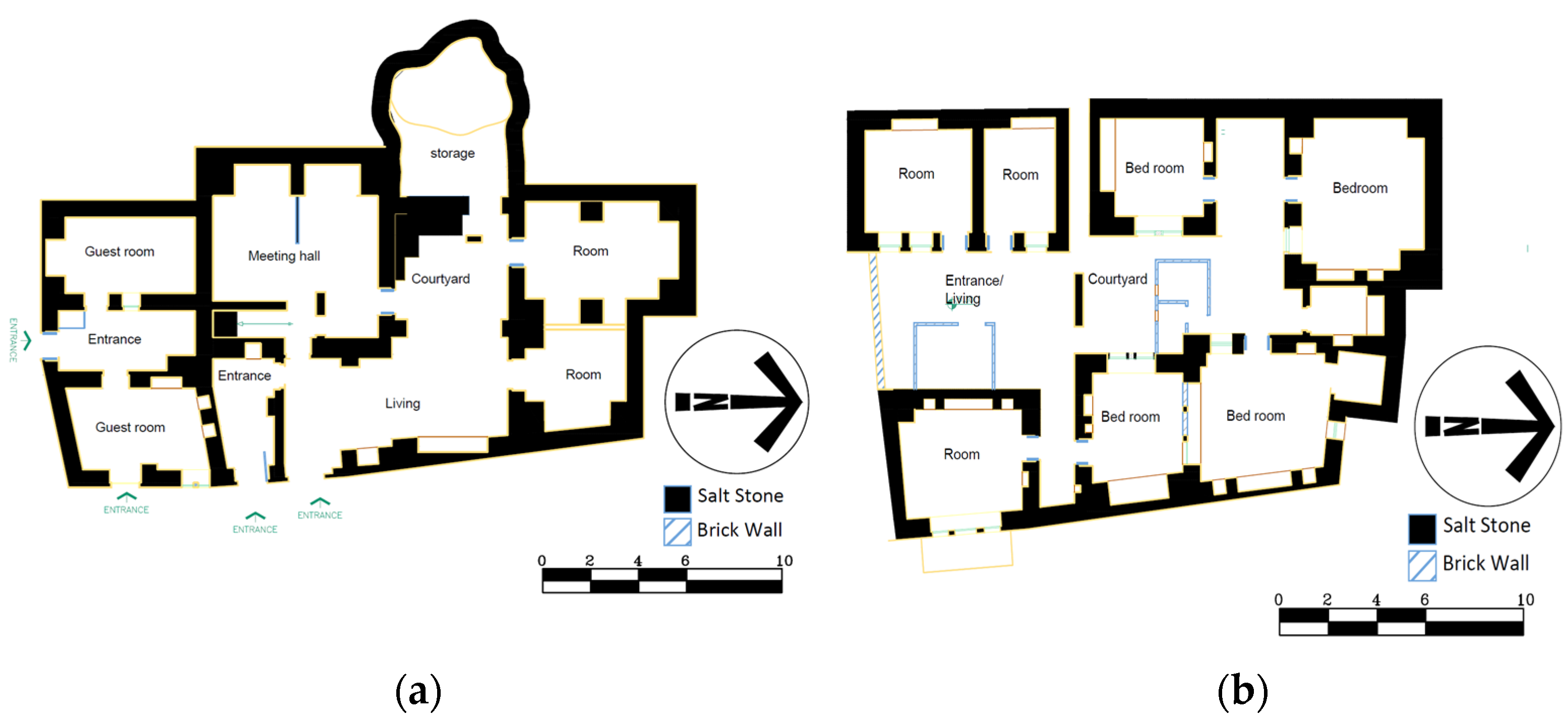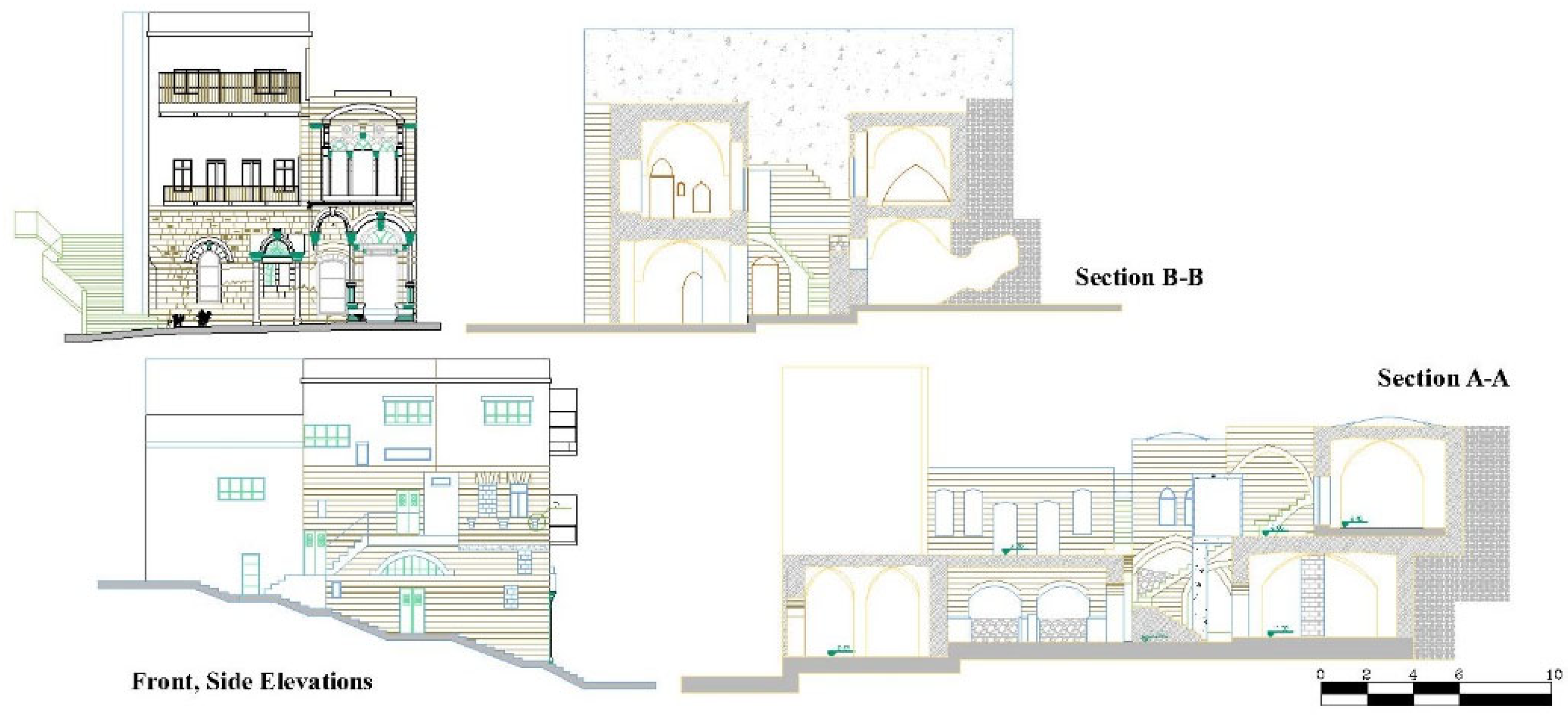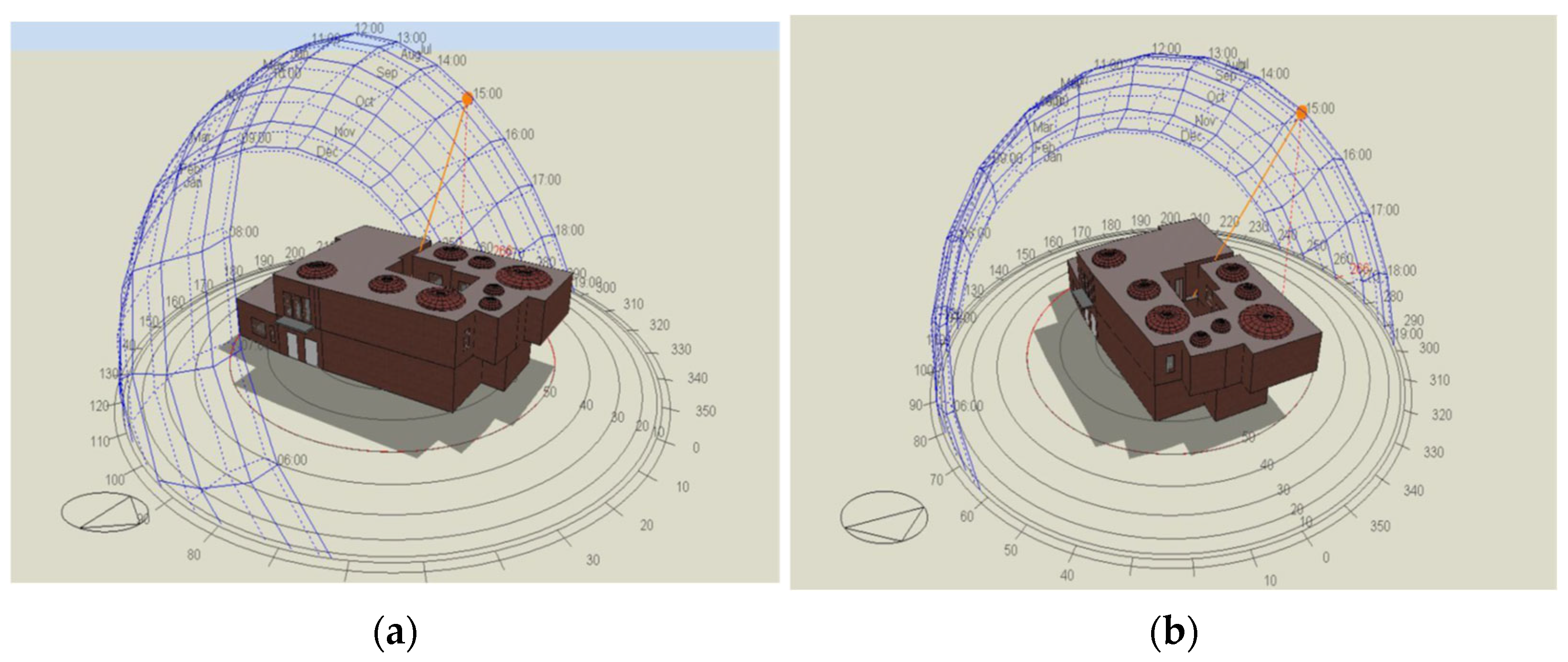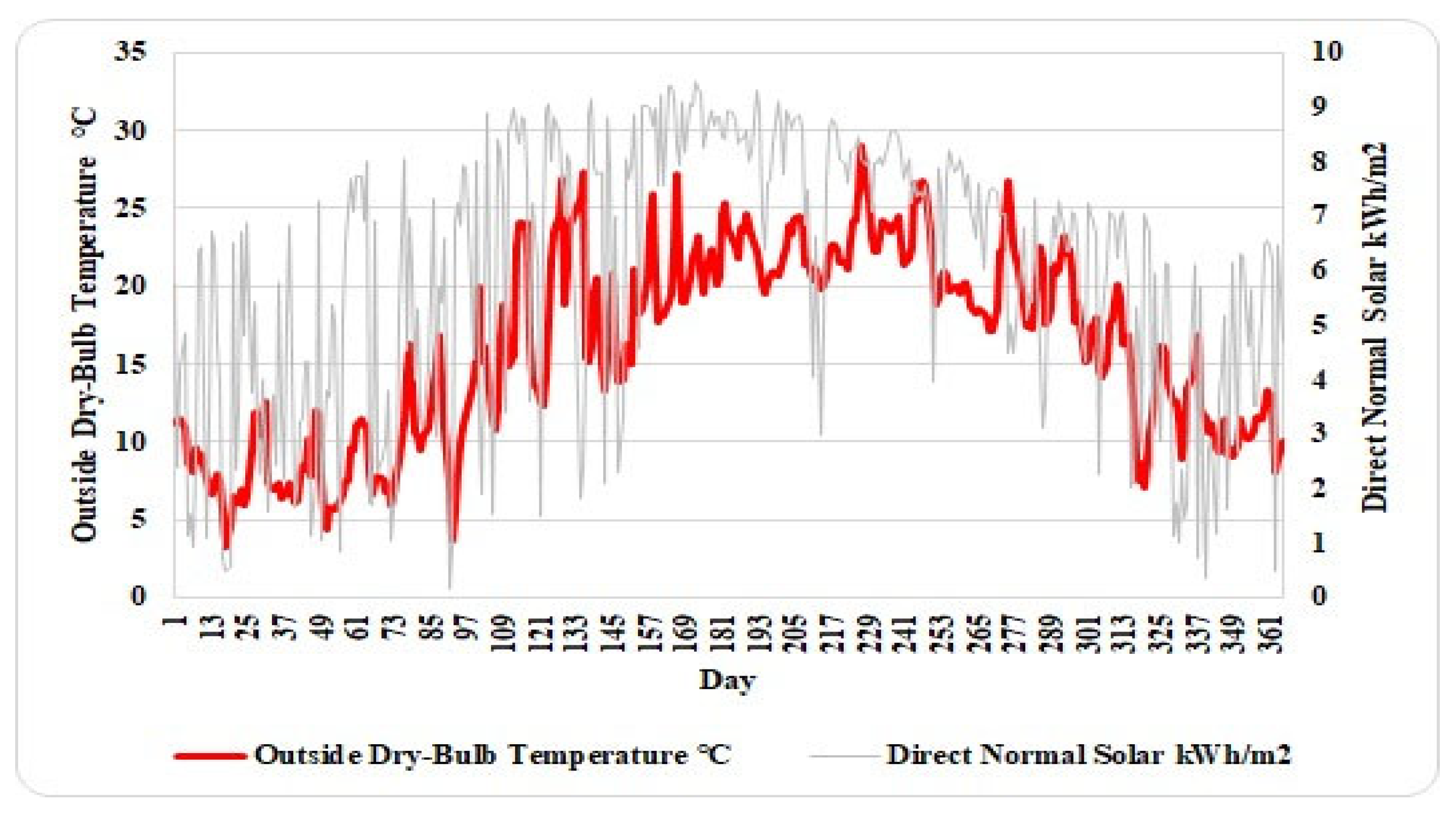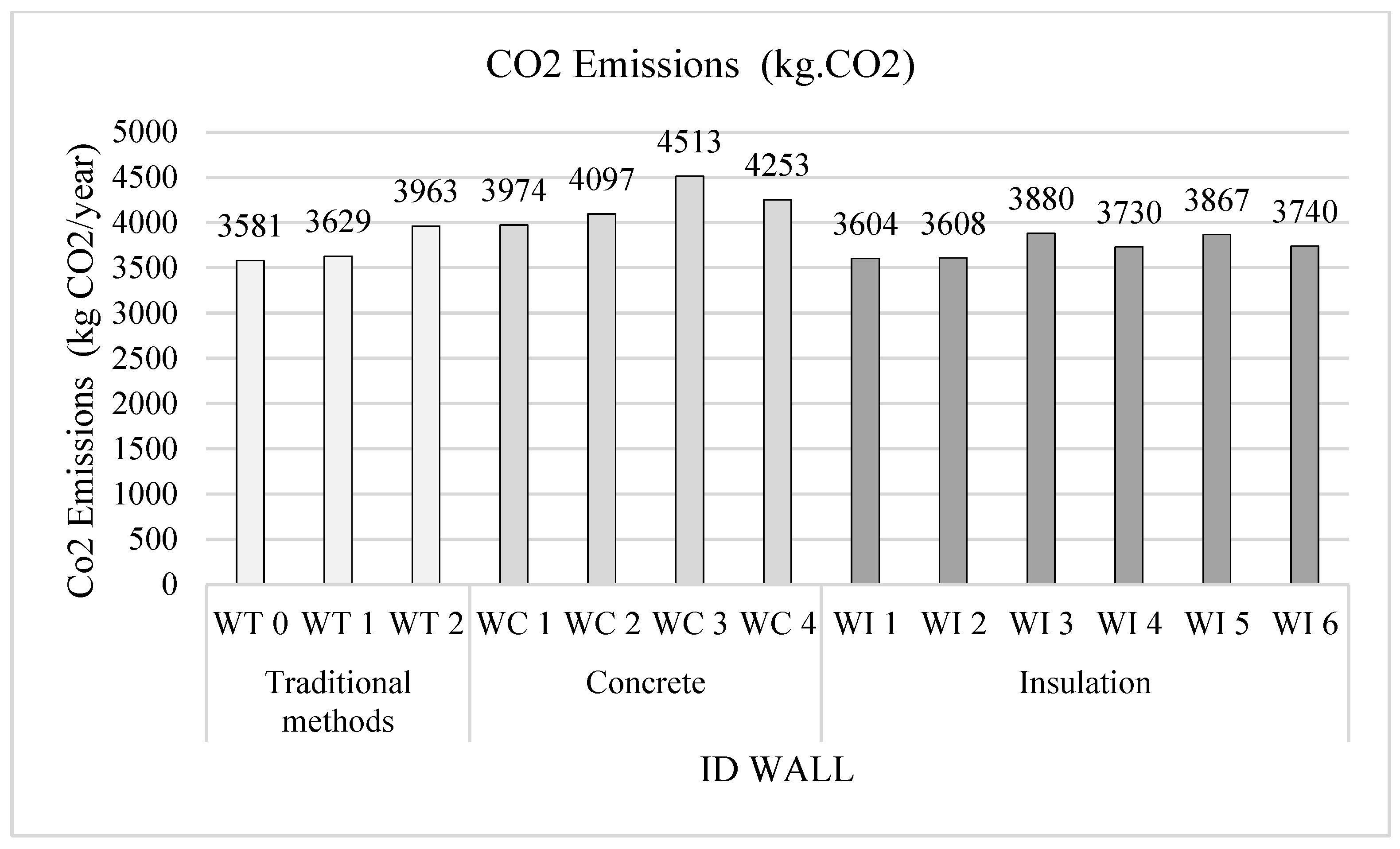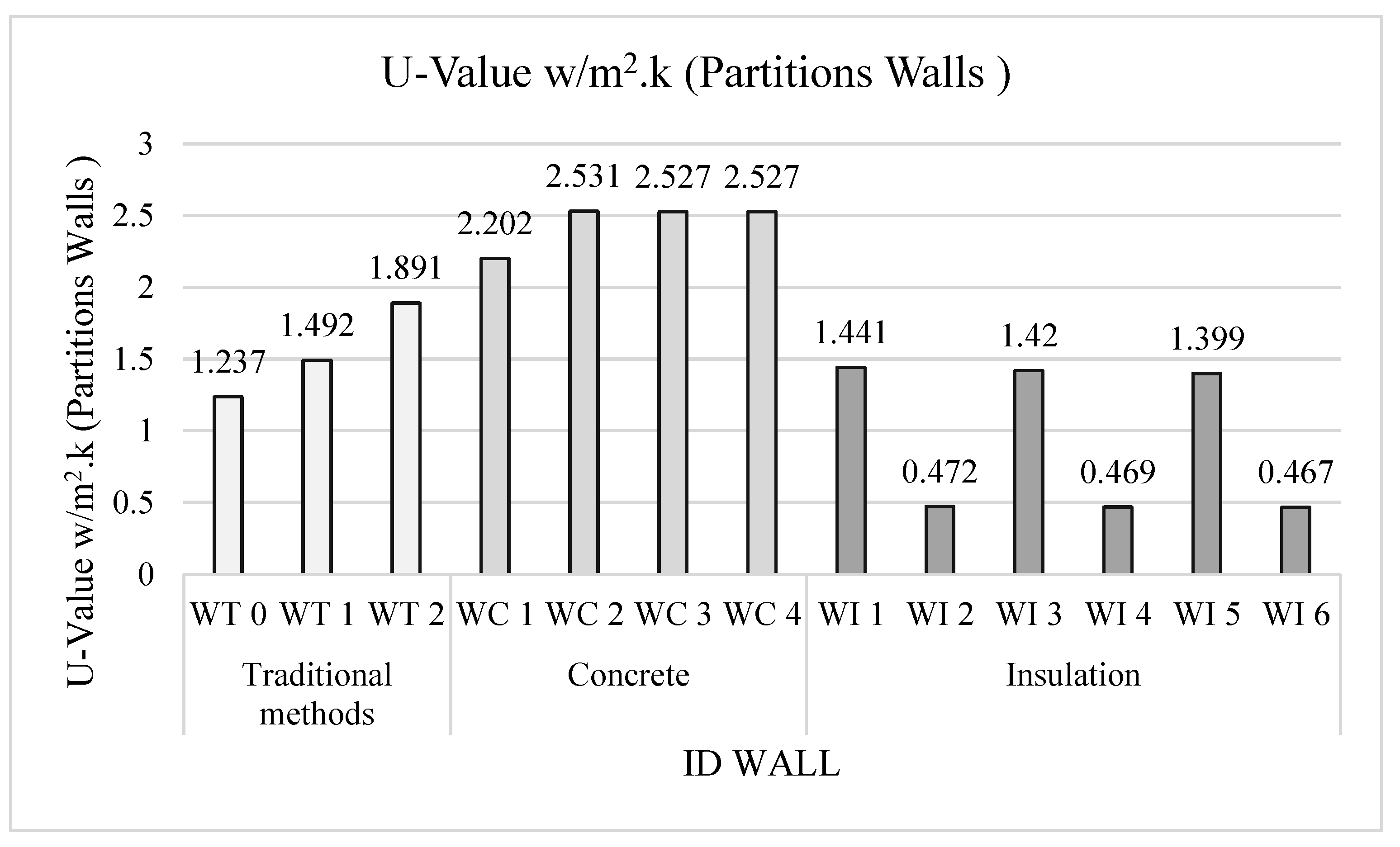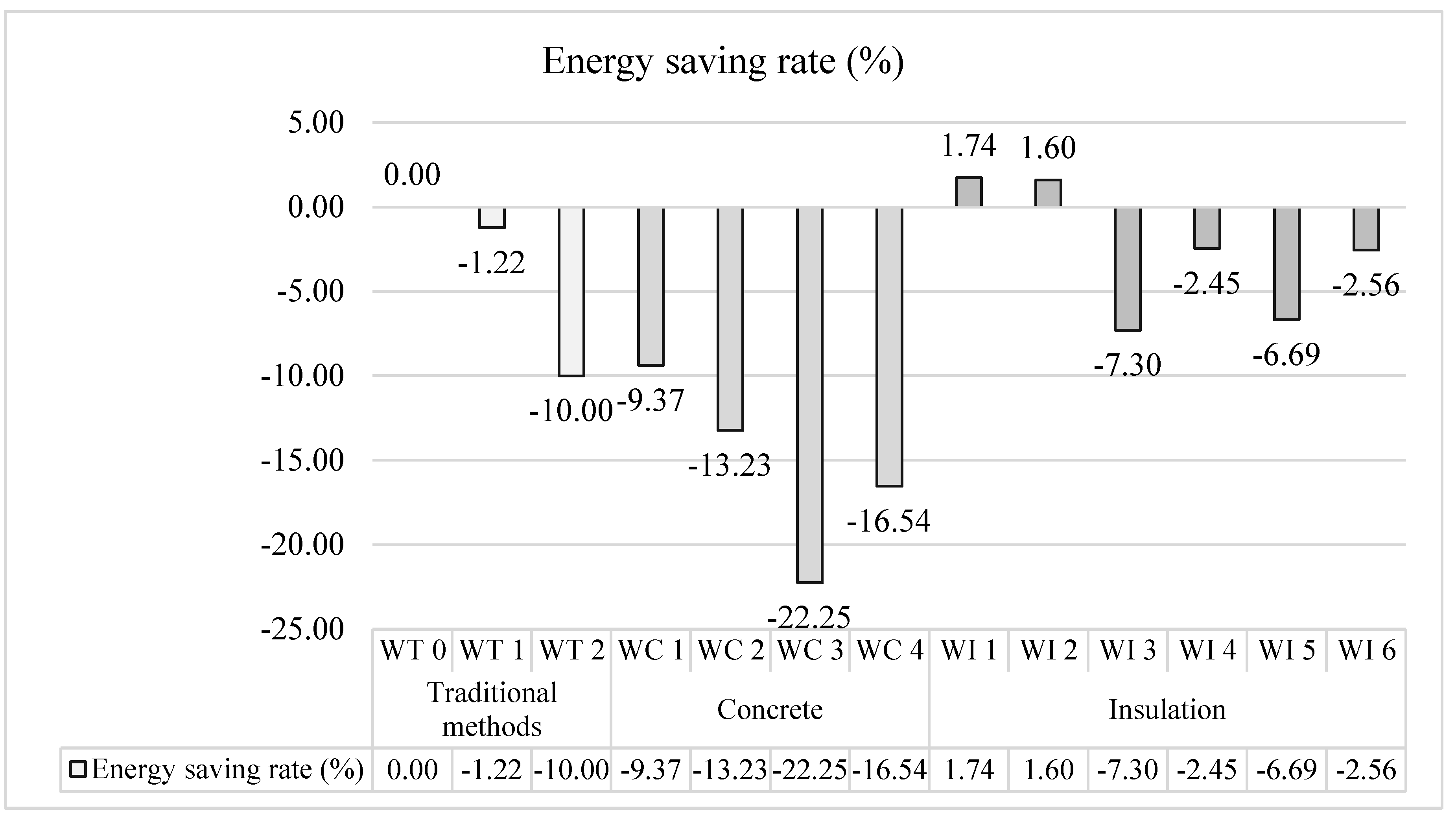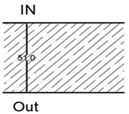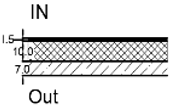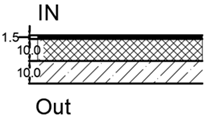1. Introduction
Buildings are a significant global user of energy that cause a huge increase in greenhouse gas emissions and also cause energy depletion [
1]. Global attention to using sustainable building practices that minimize a building’s ecological footprint was raised due to increased environmental concerns and the need to conserve resources [
2,
3]
Within this global framework, unique energy obstacles are indeed encountered in Jordan. The entire nation relies exclusively on imported energy sources; therefore, it is completely critical that all diverse sectors, including the built environment, effectively conserve energy [
4]. Jordan’s rich architectural heritage adds another layer of complexity, featuring many historical buildings holding large cultural and historical importance [
5]. In order to preserve these structures while simultaneously addressing the need for improved energy performance, we must meet a unique challenge. It is possible that traditional building techniques used in these historic structures cannot naturally match modern energy efficiency requirements [
6]. These techniques frequently make use of resources that are locally available, such as stone and mud [
7]. In this way, a sort of tension between conservation efforts and industrialized methods seems to arise.
This study addresses the critical need to evaluate the energy performance of traditional thick limestone walls in comparison with composite modern wall assemblies in heritage buildings in Al Salt, Jordan, by using dynamic simulation to assess the role of thermal mass and insulation in reducing energy demand and CO2 emissions, while emphasizing opportunities to enhance efficiency without affecting architectural identity. A key gap in the current understanding is the lack of quantitative data comparing the energy performance of traditional wall materials prevalent in these structures with commonly used modern alternatives within the specific climatic context of Jordan. To manage this gap, this study develops a clear energy model of a traditional heritage house located in Al Salt, Jordan, utilizing DesignBuilder software for the purposes of simulating its baseline energy performance, considering its existing conventional stone and mud wall construction. Moreover, the study simulates the energy performance under three alternative scenarios, where the traditional wall materials are systematically replaced with three distinct types of commonly utilized modern wall materials in the Jordanian construction industry. The study conducts a comprehensive analysis that compares the energy efficiency of the traditional walls and the three modern wall material types according to the results derived from the DesignBuilder simulations. This further contributes to assessing the potential for energy savings, in terms of heating/cooling energy demands, that could be achieved by replacing traditional wall materials with the selected modern alternatives, as replacing traditional wall materials with selected modern alternatives could lead to significant energy savings. However, this would likely involve substantial modifications to a building which may not be feasible in practice, particularly for heritage buildings. A complete retrofit that involves entirely replacing existing walls may not always be a viable solution due to historical preservation concerns and the structural implications of such a change. Instead, this study suggests that a more practical approach could involve hybrid solutions, where traditional materials are combined with modern insulation technologies to improve energy performance without compromising the building’s aesthetic and cultural value.
Through its methodological approach, the research results identify the baseline annual energy consumption, and heating and cooling demands, of the heritage facility in Al Salt when modeled with its existing traditional stone and mud walls. Also, it highlights how the energy performance characteristics (specifically regarding heat transfer and insulation) of the three selected modern wall materials compare to those of the traditional stone and mud walls within the distinct site of this case-study house and the climate of Al Salt. Lastly, it assesses the possible yearly energy savings that could be achieved by swapping out the conventional walls in the case-study home for each of the three contemporary wall material options, measured in terms of lower heating and cooling loads.
Because they offer useful, data-driven knowledge regarding the energy performance exhibited by conventional and contemporary wall materials within the unique climatic circumstances of Al Salt, Jordan, the study’s findings have a great deal of potential in benefitting a variety of stakeholders. In particular, the results emphasize the incomparable performance of composite wall assemblies over single-layer walls, underscoring their significance in achieving energy efficiency while maintaining cultural and architectural integrity.
Also, it will offer practical information for the local community and policymakers regarding options for energy-efficient retrofitting for the vast context of heritage buildings within the city and potentially inform decisions for selecting suitable materials. Furthermore, by offering a quantitative evaluation of potential energy upgrades, this work advances the more general objective of creating sustainable preservation plans for Al Salt’s distinctive architectural heritage sites that may be applied in comparable situations. Lastly, the study demonstrates how DesignBuilder, a building energy simulation technology, and similar technologies may be of effective use to exploring and assessing the energy performance of current buildings, especially heritage buildings that hold historical significance.
2. Literature Review
2.1. Principles and Factors for Energy Efficiency in Buildings
Given that the building industry contributes significantly to both overall usage of energy and greenhouse gas emissions, there is a critical necessity for increased energy efficiency in this sector, which has attracted international attention [
8,
9]. Reducing building energy consumption has become a crucial tactic as environmental concerns grow and the need for sustainable development becomes more pressing [
10,
11]. Therefore, it is crucial to comprehend the basic ideas guiding the flow of energy and usage in buildings in order to create energy-saving solutions that work, especially when taking into account the performance of various building types and materials [
12].
Fundamentally, regulating the flow of heat across interior and exterior spaces is the main goal of energy efficiency in buildings. Convection, radiation, and conduction are the three main ways that heat is transferred in buildings [
13]. This exchange is largely controlled by the building envelope, which is made up of components including the floor, windows, roof, and walls. Key concepts influencing a building’s energy performance include thermal insulation, which impedes conductive heat flow; thermal mass, which affects a building’s ability to store and release heat; the control of air infiltration and ventilation to manage convective heat transfer and indoor air quality; and the management of solar energy absorption through appropriate design and sun protection strategies [
14]. Furthermore, variables such as the prevailing climate, architectural elements of the facility (such as orientation and fenestration), and, to a lesser extent in this study, user behavior and the efficiency of building systems, all together, affect the overall consumption of energy in residential buildings [
15].
2.2. Energy Performance of Traditional and Modern Building Materials
Since building materials directly affect how quickly heat moves through the building envelope, choosing the right ones is essential to attaining energy efficiency in structures. Predicting how various materials may affect cooling and heating demands requires an understanding of their intrinsic thermal characteristics. Key thermal properties that dictate a material’s energy performance include thermal conductivity (λ or k), which quantifies its ability to conduct heat; thermal resistance (R-value), representing its opposition to heat flow and often used to describe the insulating capacity of a material or assembly; specific heat capacity (cp), which indicates the heat energy required to alter the temperature of one unit of mass of a material; and density (ρ), which contributes, together with the specific heat, to the thermal mass of a material as well as to the material’s ability in storing heat [
16,
17]. The relationship between the properties of materials is considered a good indicator of its effectiveness in resisting the transfer of heat and contributing to the overall occupant thermal comfort and building energy performance.
Traditional building materials like mud and stone were widely used for centuries in various climatic zones such as the Middle East. Research regarding the thermal properties of stone usually emphasize how it has a relatively high thermal mass as well as a moderate thermal conductivity that contributes to thermal stability as, over time, it absorbs and releases heat slowly [
18,
19]. On the other hand, mud material can exhibit variation in its thermal properties, which depends on factors like composition and density. However, mud is acknowledged, in general, for its good thermal regulation, as well as its wide availability in many regions and a diversity of climatic zones [
20]. The literature evaluates the advantages and disadvantages of these traditional materials as, in general, they address issues besides the materials’ thermal performance. Studies highlight factors like compatibility with local climate conditions, the material’s affordability, cost, and its embodied energy [
21].
In contrast, modern building materials, which are usually used throughout Jordan, such as concrete blocks with plaster, insulated concrete blocks, and hollow clay bricks with plaster and insulation, are often chosen due to their easy use within construction and also their higher capacity for insulation. Unless insulation is added, concrete blocks show low structural strength and relatively low thermal resistance, as highlighted throughout relevant studies on concrete blocks [
22]. In the same way, studies on insulated concrete blocks frequently concentrate on incorporating insulation to increase R-values and decrease heat transfer [
22]. Lastly, research on hollow clay bricks may emphasize how lightweight they are and how their thermal efficiency is affected by the hollow chambers and additional insulation [
23]. Comparative evaluations of these contemporary materials regularly evaluate the materials’ properties, like their R-values, efficiency, and thermal conductivity, to determine how the energy loads for space conditioning can be lowered [
24].
Recent improvements in numerical methods, like transient simulations and modified Dufort–Frankel techniques, have made heat transfer simulations in multilayer walls more accurate. These methods help find the best thickness of insulation and energy efficiency, which is useful for figuring out how well both old and new wall materials work in heritage buildings [
25].
2.3. Heritage Structures’ Energy Efficiency Potential and Difficulties
Heritage buildings, with their cultural, historical, and architectural significance, are considered an important link to the past of a region that must be preserved with care [
26]. However, when high energy efficiency is required, heritage structures usually present some unique challenges [
27]. Traditional energy techniques of retrofitting may come in conflict with the need for maintaining a heritage building’s original structure, architectural elements, and material authenticity. Maintaining the historical value of these priceless artifacts while improving energy performance requires a careful balancing act.
The inherent qualities of heritage buildings’ past construction techniques and materials present one of the main obstacles to adapting them. As discussed in the previous section, materials like stone and mud possess certain thermal potentials, but they may not always meet the standards of contemporary energy efficiency and insulation levels. Also, detailing and building assemblies are often involved in traditional construction, which require specialized knowledge and careful consideration when planning energy for upgrades [
28].
There are plenty of chances to increase the energy effectiveness of heritage structures in spite of these obstacles. An investigation of many approaches for achieving significant energy savings without affecting the heritage fabric includes minimally invasive techniques such as improving window performance through secondary glazing or shutters, enhancing roof insulation from the interior, and addressing air leakage through careful sealing of gaps and cracks [
29,
30]. In some cases, material replacements may be considered, but these often require careful selection to ensure compatibility with the original materials and aesthetic considerations [
31].
Additionally, better efficiency can be achieved by comprehending and maximizing the built-in energy-efficient elements of traditional architecture, such as natural ventilation techniques and thick walls that provide thermal mass [
32]. Good information on some good strategies and evidence on real energy savings can be seen in case studies of heritage buildings that have successfully undergone energy retrofits, particularly those in comparable temperature zones or those using the same locally available materials [
33,
34].
2.4. Using Building Energy Simulation to Assess Material Performance
Building energy simulation (BES) has become a widely adopted methodology for analyzing and optimizing energy performance in the built environment. Simulation tools have been utilized in the evaluation of different design choices and material selections for their impact regarding energy use in buildings, as evident in relevant existing research [
35]. Those methods and their implementation involve the examination of the energy performance implications of various building materials, particularly concerning their thermal properties and their impact on heating and cooling demands.
Numerous studies have employed software for BES to conduct an evaluation of alternative wall construction systems, insulation materials, and glazing systems in the energy efficiency of buildings across a range of regions with different climatic conditions [
36,
37]. Investigations on energy performance usually quantify the differences in energy demand that are associated with different material choices, identify materials that offer superior thermal performance in specific contexts, and evaluate the potential for energy savings through informed material selection [
38]. Some research have also focused on utilizing simulation to analyze the effectiveness of material upgrades in retrofitting existing buildings, demonstrating the capacity for energy savings and enhancing thermal comfort through targeted material use [
39,
40]. Even with different simulation tools, the main idea is always the same: building a digital version of a building to understand how energy moves through it, considering its materials and the outside environment, which also helps to provide crucial information on approaches for optimizing energy performance in buildings.
2.5. Building Construction Practices and Materials in Al Salt, Jordan
It is important to understand the construction methods and materials used in Jordan to assess energy efficiency within a heritage building in Al Salt through its context [
41]. The precise kinds of stone utilized, the makeup of mud mixtures, and the building methods utilized frequently differed by place and were tailored to the local environment and resources [
42]. In Al Salt, the characteristic terraced architecture often features load-bearing stone walls, sometimes incorporating mud mortar or renders, reflecting both the availability of local stone and the need for thermal regulation in the region’s climate [
43,
44].
Jordan’s modern construction now increasingly utilizes conventional alternatives. These include concrete blocks with plaster, insulated concrete blocks, and hollow clay bricks, often integrated with both plaster and insulation [
45]. These materials are primarily chosen for their robust structural properties, ease of construction, and perceived durability, such as the wide use of concrete blocks for structural walls which often require additional insulation to meet thermal comfort standards. Furthermore, local building codes and regulations in Jordan may influence the selection and application of these modern materials, potentially including requirements related to thermal performance [
46,
47].
2.6. Regional Context: Energy Efficiency in Heritage Buildings in the MENA Region
The energy performance of heritage edifices in the Middle East and North Africa (MENA) has assumed prominent significance against the concurrent imperatives of climatic adaptation and cultural preservation. The region’s predominantly hot and arid zones exact strict limitations on energy-conserving retrofits, thereby complicating the maintenance of both thermal performance and architectural integrity. Recent investigations, centering on historic complexes in Egypt and Jordan, elucidate the theoretical and operational frameworks that reconcile thermal optimization with the preservation of authentic heritage fabric [
48].
An empirical investigation undertaken on the adaptive re-use of the Cairo Citadel is illustrative. The project, conducted within the historic core of the Citadel, utilized analog energy-performance modeling juxtaposed with empirical sensory monitoring in inhabited zones. The research demonstrated that retrocession layers, the reconfiguration of internal thermal mass, and indirect ventilation devices can be assimilated without inflicting visible damage, provided that the measures are prescribed within defined reversibility criteria. Key performance indicators confirmed gains exceeding 23 percent in daily thermal energy demand, concomitant with subjective improvements in occupant thermal comfort and a diminished empirical carbon balance [
49].
Similarly, within the Egyptian context, inquiries into the energy performance of residential green heritage edifices have highlighted the imperative of reconciling enhanced energy efficacy with the safeguarding of cultural values. The findings indicate that the principal hurdle of retrofitting such patrimonial structures resides in the obligation that measures—whether the installation of thermal insulation or the incorporation of high-efficiency mechanical services—must abide by the attributes of the permanent heritage fabric. Such diligence is vital for the conservation of architectural identity while fulfilling the prescribed energy performance benchmarks [
50].
A further illustrative investigation by Wekalet El-Ghouri reaffirms the necessity of an energy performance regimen in heritage edifices. The findings disclose that the repository of traditional development techniques—characterized by massive masonry walls and high ceilings—afford an acceptable degree of thermal steadiness yet fall short of contemporary energy expectations. The project therefore advances a streamlined protocol for the quantification of energy performance within patrimonial structures, reasserting the predominant need for interventions that procure stable energy dividends while meticulously avoiding disturbance to original architectural features [
51].
The sustained climatic conditions of the MENA region—characterized by extreme heat and limited moisture—have catalyzed a concerted effort to humor nearly zero-energy targets for heritage architecture through precisely crafted retrofitting measures. Recent investigations assert that any effective intervention must be underpinned by regionally calibrated methodologies that maximize energy efficiency yet leave the original fabric of the heritage edifice intact. Investigational pilots within Jordan—most notably the concerted retrofitting of the Abu Jaber House in Al Salt—quantitatively verify that judicious application of contemporary thermal insulation strategies yields a meaningful contraction in energy demand. The intervention in Al Salt was meticulously orchestrated to safeguard the visual and tectonic traditions of the dwelling while securing pronounced and quantifiable reductions in resource consumption, thereby demonstrating the compatibility of heritage conservation with contemporary carbon-reduction priorities [
5].
The body of research originating from the MENA region concisely corroborates the rising imperative to implement energy-efficient retrofitting strategies within the corpus of built heritage. While the survey of traditional construction materials confirms their effective thermal mass, the empirical evidence continues to contend that such materials frequently fall short of prevailing energy-performance criteria. Accordingly, the introduction of contemporary energy-saving technologies emerges as a necessity, albeit one that mandates judicious application to preclude the erosion of heritage significance. Synthesizing the evidence from the regional studies thus furnishes a substantive frame of reference for delineating the energy-efficiency impediments and opportunities presently confronting heritage edifices in Jordan and analogously situated MENA territories, as demonstrated in the concurrent and complementing analyses.
In light of the discussed studies, this study compares the energy efficiency of three widely used contemporary wall materials in Jordan with the traditional walls of a heritage building in Al Salt. This study can more precisely assess energy-efficient retrofitting strategies appropriate for the context by bringing an understanding of both the region’s traditional construction practices as well as of newly used building materials.
3. Materials and Methods
A case study approach is employed in this research to examine the energy performance of a historic heritage building in Al Salt, Jordan. The research has three main goals: to analyze the energy efficiency of the building, to compare the energy efficiency of traditional and modern wall materials, and to explore potential alternative materials. This analysis was performed using the energy simulation software DesignBuilder. This enabled a detailed assessment of the thermal behavior and energy consumption of various construction materials.
3.1. Description of the Building
This work is conducted in Al Salt city, Jordan, designated as a World Heritage Site in 2021 by UNESCO for its rich history and urban character. The historic center of the city presents a unique townscape that features Ottoman architecture of yellow limestone [
52]. The case study is a heritage residential house built around 1860–1900 in the historic center and is known locally as the Khader center (previously the Jaghbeer family residence), shown in
Figure 1.
The building resembles a rectangular architectural plan measuring 24.42 m × 16.23 m, comprising two floors (ground and first), with the ground floor covering an area of 396.3 m
2 and an overall height of 4.55 m. The total external wall surface area of the house, including both the ground and first floors, is 3.5 m
2. It has a north–south (0.0°) orientation on its longitudinal axis. Detailed architectural drawings used in the generated simulation model of the building are presented in
Figure 2 and
Figure 3, respectively. There is a group of studies that used the DesignBuilder program in the computational verification of the heritage buildings under study [
56,
57,
58].
The existing external walls of this heritage building, which served as the base case, are constructed from 51 cm of stone–limestone, possessing a U-value of 1.392 W/m
2 K [
59]. The building’s window-to-wall ratio (WWR) is 15%, and the windows feature 6 mm clear glass with a solar heat gain coefficient (SHGC) of 0.810, a light transmittance (LT) of 0.881, and a U-value of 6.121 W/m
2 K. The roof is composed of 85 cm of compacted clay, resulting in a U-value of 1.415 W/m
2 K. These simulation specifications are presented in summary in
Table 1. All data shown in
Table 1 are from a field survey of the model under study or commonly used in these residential buildings. In most international studies and standards, such as ASHRAE 55 [
60], the optimum thermal comfort levels in winter are between 20 and 26 °C, and between 23 and 29 °C in summer. A uniform temperature of 23 °C was set for both summer and winter to achieve the optimum indoor thermal comfort, which was maintained in all tests [
61].
3.2. Simulation Software and Model
The study uses the DesignBuilder tool to perform the building energy performance simulations, which is a robust graphical interface of the EnergyPlus simulation engine. This selection was based on the software’s broad capabilities in accurately modeling elements like building form, material specifications, internal thermal loads, HVAC system parameters, and climatic conditions. Creating the model, shown in
Figure 4, involved inputting the building’s architectural and materials specifications.
The building under study was carefully surveyed, its components analyzed and accurately entered into the DesignBuilder program. Simulations were conducted several times, ensuring that the same result was obtained each time. DesignBuilder is an analytical tool based on the popular EnergyPlus simulation engine, developed by the US Department of Energy (US DOE). DesignBuilder’s results are recognized by several green building rating systems and international standards like LEED, ASHRAE 90.1, BREEAM, and MOSTADAM.
3.3. Material Properties
The study examined the thermal characteristics of different materials employed in both the conventional and proposed new wall materials. The specific values for all wall types are found in
Table 2. Their respective thermal conductivity, density, and specific heat capacities are provided in
Table 3.
Conventional (traditional) wall materials: The primary material is limestone, whose properties are detailed in
Table 1.
New proposed (modern) wall materials: A range of modern materials was considered for the comparative analysis, including cement blocks, reinforced concrete, clay or silt, plaster/mortar, and XPS-extruded polystyrene.
In the baseline scenario (WT0), the traditional wall construction consists of thick stone–limestone walls combined with mud, representing the heritage building’s original material composition. This scenario serves as the reference case for comparing the energy performance of modern wall materials and insulation solutions.
3.4. Simulation Scenarios
A total of 13 distinct wall constructions were modeled and then simulated in order to compare their performance with regard to energy:
Base scenarios: The base case for all comparisons is the existing traditional wall, specifically the 51 cm limestone wall with ID# WT0.
Alternative scenarios: Other simulation scenarios included two additional traditional walls constructed from limestone types with reduced thicknesses, with given ID#WT1: 38 cm; and ID# WT2: 25 cm. Also, the study proposes the investigation of ten other new wall types that are divided into two main categories, which are grouped based on their primary construction method as follows:
Concrete walls: Four different concrete wall compositions, ID# WC1, WC2, WC3, and WC4.
Insulated walls: Six different insulated wall compositions, ID# WI1, WI2, WI3, WI4, WI5, and WI6. Detailed in
Table 3, each wall represents a multilayered combination with specific material arrangements and total thicknesses. These scenarios were created with the goal of identifying the most energy-efficient construction solutions.
3.5. Simulation Settings, Parameters, and Comparative Analysis
The simulations use a typical meteorological year (TMY) and weather data, which is obtained from Jordan at the Amman Airport. Also, internal conditions within the building model were defined based on the factors given in
Table 1: occupancy, artificial lighting, and HVAC system.
Figure 5 shows the climate of the study area. It displays the daily mean air temperatures and direct normal radiation at Amman Airport, Jordan, for a typical meteorological year. These climate data serve as the boundary conditions used in the energy simulation of the heritage building in Al Salt. The climate data file from Amman Airport is the closest climate data file approved by EnergyPlus. In addition, the city of Al Salt is in the same climate region as the city of Amman. The distance separating the borders of the cities of Amman and Al Salt is estimated to be only 6 km, so there is no significant difference between the climate data files of the two cities.
For each wall scenario being simulated, key performance indicators were extracted and analyzed. These included the following: annual energy consumption (kWh/year), CO2 emissions (kg.CO2), U-value for external walls (W/m2 K), U-value for internal walls and partitions (W/m2 K), and energy saving rate (%). The metrics given were all compared among all wall types: traditional, concrete, and insulation methods were compared against the primary base wall, a traditional wall constructed from limestone with a thickness of 51 cm to assess the relative energy performance of each wall type, highlight the effectiveness of traditional building methods versus modern construction materials, and identify the most energy-efficient construction solutions for heritage residential buildings in the specified climate, as shown in the Results section that follows.
4. Results
This study analyzed the energy demand and thermal response of various wall materials in a heritage house located in Al Salt, Jordan. The study considered both traditional stone and mud walls and compared them to several modern wall materials, including cement blocks, reinforced concrete, and insulated materials. The results of the simulations, shown in
Table 4, provide insights into the energy consumption, CO
2 emissions, and U-values for each wall type.
4.1. Energy Consumption (kWh/Year)
Energy consumption includes the energy consumed in achieving the building’s interior comfort (total cooling (kWh/year)). The total design loads of energy for the different wall constructions are given in
Figure 6. The constitutive traditional wall constructed from limestone with a thickness of 51 cm (WT0) that defined the base was characterized by an annual energy demand of 4689 kWh, and simply turned out to be selected as the reference case with which other walls were compared.
Both thinner walls made of limestone (WT1 and WT2) did not significantly increase the energy demands, where WT1 consumed 4747 kWh/year and WT2 consumed 5210 kWh/year. This finding demonstrated that a thinner wall brought about the increased energy requirement for heating and cooling. WC3 was the most energy-demanding concrete wall with 6031 kWh/year, thus confirming that thicker concrete structures, especially the walls reinforced with steel structures, use more amounts of energy to keep themselves warm.
The energy performances between the levels measured outside and inside the walls (WI1 to WI6) were substantially improved in the six insulated walls. Energy consumption in WI1 and WI2 were the lowest of all, and WI2 has an annual demand of 4609 kWh, a 1.6 percent decrease compared to the baseline, becoming more energy efficient than the 51 cm limestone wall.
If we interpret the results of energy consumption per square meter of the building’s floor area, the highest energy consumption was for the WC3 walls, which was 6031 kWh/year. Dividing it by the building’s floor area, which is estimated at 396.3 m2, the result is that each square meter of flooring consumes 15.22 kWh/year. One of the best results of the WI2 walls was the consumption by each square meter of flooring of 11.6 kWh/year.
4.2. CO2 Emissions (kg.CO2/Year)
Figure 7 demonstrates the CO
2 emissions in accordance with each variant of the walls evaluated in the current study. The baseline wall (WT0) released 3581 kg.CO
2/year. Thin limestone walls increased emissions; in WT1 they amounted to 3629 kg.CO
2/year, whereas in WT2 it was 3963 kg.CO
2/year. Completely concrete walls emitted significantly more; WC3 was measured at 4513 kg.CO
2/year, reflecting relatively higher energy-requiring materials with low thermal conductivity. Insulated walls fared better, whereby WI2 had the best emission of 3608 kg.CO
2/year, similarly to its better performance with energy.
The CO2 emissions presented in this section refer to the carbon dioxide emissions resulting from the building’s energy consumption, specifically related to heating and cooling demands. These emissions vary depending on the wall types and the effectiveness of insulation, as different materials impact the building’s energy requirements.
4.3. U-Value (Thermal Transmittance)
The U-value of the exterior walls displays the index of resistance to heat transmission of every material, as can be seen in
Figure 8.
Conventional limestone walls (WT0) had a U-value of 1.392 W/m2 K, implying low-to-moderate levels of insulation. The U-value, with thinner walls, rose to 1.728 W/m2 K (WT1) and 2.279 W/m2 K (WT2) in sequence, demonstrating that thinner walls are worse insulators.
U-values of concrete walls (WC1–WC4) were significantly lower, where WC3 equaled 3.27 W/m
2 K, already showing the poor insulating characteristic of concrete walls. Insulated walls performed best, demonstrating an optimal insulating capacity as the U-value of WI2 was the lowest at 0.492 W/m
2 K, as shown in
Figure 9.
4.4. Energy Saving Rate (%)
Energy saving rate is depicted as the percentage that shows the decrease in energy usage as compared to that of the baseline scenario (WT0). The strategies related to insulated walls (WI1–WI6) have rather low energy savings. WI1 results in the largest enhancement, a savings of 1.74%, whereas WI2 yields a 1.60% savings, as shown in
Figure 10.
The results show that concrete walls, WC3 in particular, perform poorly, and its rate of energy saving is negative, −22.25%, which implies that in comparison with the traditional 51 cm wall made of limestone, it is less efficient with regard to energy saving.
5. Discussion
Given these facts, this study explored the thermal performance of various heritage building wall elements specific to Al Salt, Jordan. The findings show significant differences in the materials, and they highlight the defining role of material choice in energy retrofitting. As compared to the literature, it can be noted that modern insulation systems tend to be better than traditional ones.
5.1. Discussion of Findings
The results of this study align with previous research [
21] which compared the life cycle assessments (LCAs) of traditional and modern building elements in heritage structures. Both studies emphasize the role of thermal inertia provided by stone and mud in regulating internal temperatures. However, the results here show that lower stone thickness (WT1 and WT2) is associated with higher energy consumption, supporting previous studies which argued that additional insulation is necessary to meet contemporary energy efficiency standards [
26]. Despite the natural thermal mass of traditional materials, this finding highlights the need for further actions, such as insulation upgrades, to improve energy performance.
It is important to note that the studies referenced here were conducted in different climatic conditions. While in previous studies [
21,
26] the authors focused on temperate regions, this study specifically examines heritage buildings in Al Salt, Jordan, which has a hot, arid climate. The climatic differences mean that the thermal performance of materials like stone and mud may vary significantly, and the need for insulation could be more pronounced in warmer regions like Al Salt.
In contrast, the performance of concrete-based assemblies (WC1–WC4) reflects similar findings as in [
23], which reported that uninsulated concrete walls lead to higher energy demands and greenhouse gas emissions. Notably, WC3 exhibited significantly high energy consumption (6031 kWh/year) and a high U-value (3.27 W/m
2·K), indicating poor thermal performance. These results corroborate other conclusions [
22] which found that uninsulated concrete walls cannot be effectively retrofitted for energy efficiency. Other studies also highlighted that concrete, by itself, lacks sufficient thermal resistance and requires additional insulation to achieve energy savings [
17].
Concrete walls (WC1–WC4), especially WC3, perform poorly because of their high thermal conductivity and insufficient thermal mass. Unlike traditional materials like limestone, concrete cannot naturally moderate temperature fluctuations by storing and releasing heat gradually, which results in higher energy consumption because more energy is needed for heating and cooling to maintain a comfortable indoor temperature. In contrast, thinner limestone walls (WT1), which have a lower thermal mass than thicker limestone walls, perform better because of their moderate thermal conductivity, which enables them to retain and regulate heat more effectively, lowering energy demand and improving energy efficiency. Concrete walls, especially those without additional insulation, struggle to match the thermal performance of materials like stone, which contributes to their poor performance in energy consumption and negative energy savings.
The insulated assemblies (WI1–WI6) demonstrated the best performance across the board, with WI2 and WI6 achieving the highest energy savings and the lowest CO
2 emissions. This supports previous findings [
24] which confirmed that insulation drastically reduces energy demand and CO
2 emissions. It is also further affirmed that upgrading the insulation of heritage buildings reduces energy consumption without compromising their architectural integrity [
40]. Specifically, WI2, with 1.60% energy savings, proved to be the most efficient in terms of CO
2 emissions, aligning with previous work that observed similar benefits of insulation in hot climates like Al Salt [
39]. The relatively modest energy savings of 1.6% to 1.74% are due to the already high thermal mass of the baseline limestone walls. These walls naturally help keep indoor temperatures stable in Al Salt’s hot and dry climate, which limits the extra benefits from added insulation. Additionally, the savings are based on the whole building, where other elements like the roof, windows, and air leaks affect energy demand. This makes the impact of wall insulation seem smaller in percentage terms. However, the insulated walls achieve very low U-values and result in significant absolute reductions in kWh/year and CO
2 emissions. This is important for heritage retrofitting, where small yet effective changes are preferred.
Finally, the U-values of the insulated wall systems emphasize their superior insulating properties. The WI2 system, with a U-value of 0.492 W/m
2·K, outperformed all other wall types, reinforcing previously found findings that demonstrated that well-insulated walls provide far better thermal regulation and overall performance compared to traditional or concrete walls [
28].
5.2. Implications for Heritage Buildings
It is well recognized that retrofitting heritage buildings in Al Salt, which mainly consist of traditional stone-made buildings, can be improved through the introduction of modern insulation. This inference is consistent with previous studies which elaborated on measures to utilize energy efficiency to its maximum and yet not compromise the historical integrity [
29]. To reduce the energy demand and maintain structural and aesthetic value, they promote minimal interventions, including insulation retrofits, which maintain the façade.
Previous findings also claim that optimal energy performance is achieved by the intrinsic thermal mass of traditional architecture alongside the use of insulation [
32]. The empirical evidence of this work backs up that claim, showing that insulated walls are better than stone walls in both energy consumption and carbon production.
5.3. Practical Recommendations for Energy Retrofitting
According to the findings, solution WI2, which combines insulation and cement blocks, exhibits the best energy performance in terms of CO2 emissions and energy savings. However, there are significant practical issues with this solution’s use of cement blocks. Many heritage buildings, particularly those with masonry walls composed of stone or mud, do not typically use cement blocks. Although cement-based systems provide better thermal performance, retrofitting existing masonry buildings—which are the most common type in places like Al Salt, Jordan—presents a challenge.
It would take a lot of work to apply WI2 to existing structures, including adding contemporary materials like insulation and cement blocks, which might not complement the masonry walls’ structural integrity or historical beauty. This draws attention to a possible trade-off between heritage preservation and thermal efficiency. Combining conventional materials with insulation technologies that can be subtly incorporated into the current structure without sacrificing its historical significance may be a better option for masonry buildings. A more practical method of retrofitting historic structures while preserving architectural integrity is provided by solutions like WI6, which combine stone with layers of insulation.
The results indicate that insulated wall systems (WI2, WI6) performed the best in terms of CO2 emissions and energy savings. When using these solutions on historic buildings, it is important to take heritage values into account as well. The use of such contemporary materials may compromise the building’s aesthetics and architectural integrity, which are essential to its historical and cultural significance, even though WI2 (which uses cement blocks) provides better thermal performance. Traditional limestone walls, on the other hand, ensure that the building maintains its historical significance by preserving its architectural authenticity and cultural legacy, despite being less energy efficient.
This study highlights how crucial it is to incorporate energy-saving strategies that enhance thermal performance without sacrificing the building’s historic significance. Energy efficiency must be balanced with the preservation of historic buildings’ architectural and cultural legacy, especially in areas where heritage preservation is essential to tourism and community identity.
Although the savings compared to the base case are modest, WI1 and WI2 are still reasonable choices when considered more broadly. They are low-cost and simple solutions that can gradually improve energy performance. Implementing them is especially justifiable in situations where budget limits or ease of operation are important, making them useful in a decision-making process that lists multiple criteria.
5.4. Perspectives from MENA Studies in the Region
Research conducted in the MENA region, especially in Egypt and Jordan, offers significant insights into the energy efficiency of heritage structures in arid, hot climates. Previous studies showed that adding energy-saving features like insulation and solar control to Cairo’s historic buildings worked, which is in line with our findings that traditional stone walls need modern upgrades to meet energy standards without losing their cultural value [
48].
Similarly, another study talked about how important it is for residential green heritage buildings in Egypt to have energy-saving technologies that work well together [
49]. This supports the idea that modern insulation can work with traditional materials to lower energy use. More studies stressed the importance of using energy simulations to help make decisions about retrofitting [
50]. This study used energy simulations to improve wall performance in Al Salt, which is in line with that idea.
Attaining nearly zero-energy performance in heritage structures situated in hot climates necessitates a blend of passive and active strategies [
51]. This finding parallels the results of this study, which demonstrated that contemporary wall systems substantially decreased energy consumption and CO
2 emissions. A recent case study in Al Salt [
5] backs this method even more by showing how insulation and glazing technologies can make buildings more energy efficient while still keeping their historical value.
These studies from the MENA region show that we need to come up with unique retrofitting plans that use both modern technologies and traditional materials to save energy and protect heritage.
6. Conclusions
The current study explores the thermalization of a number of wall-cladding materials applied in a historic building in Al Salt, Jordan, and assesses the viability of intervention thereof to improve energy efficiency. The findings point out the following:
Traditional stone walls (WT0): Thermal stability of the thicker 51 cm thick limestone walls proved to be acceptable; thinner ones (WT1, WT2) were also found to be linked to marked growth in energy use and CO2 emission. Despite the fact that stone walls have thermal mass, it needs additional insulation so as to reach the current energy efficiency requirements.
Concrete walls (WC1 to WC4): the concrete walls, especially those without insulation, had high building energy demand and CO2 emissions. The conclusion of the findings is in line with preceding literature, highlighting the importance of insulation on energy-efficient systems of concrete walls. Uninsulated concrete walling minimizes thermal efficiency, thus necessitating the deployment of more energy during heating and cooling.
Insulated walls (WI1 to WI6): Coming out on top in the tested materials were the insulated wall systems; WI2 and WI6 achieve the lowest energy demand and lowest CO2 emissions. WI2 achieved a saving of 1.6% in energy use compared to the traditional wall, proving that modern insulated wall materials offer the best plan of action for enhancing the energy performance of heritage buildings.
While insulated wall systems (WI2, WI6) provide optimal thermal performance, the cost and feasibility of implementing these systems in heritage buildings should also be considered. Retrofitting heritage structures often involves challenges related to structural integrity, aesthetic preservation, and financial costs. The installation of modern insulation systems may require significant investment and could disrupt the building’s historical and architectural features. Therefore, a more pragmatic approach might involve hybrid solutions that integrate insulation with traditional materials to improve energy efficiency while respecting the cultural value and architectural integrity of the heritage building.
This study demonstrates that maximizing the use of insulated materials can significantly improve the energy performance of Jordanian heritage buildings while preserving their historical value. Based on the simulation results performed using DesignBuilder, the hybrid wall system WI6, which consists of 10 cm limestone (outside) + 5 cm insulation + 10 cm limestone (inside) with 1.5 cm plaster layers on both sides, provides a practical and effective solution. WI6 achieves a U-value of 0.487 W/m2·K. It reduces annual energy consumption and CO2 emissions compared to the baseline traditional wall constructed with limestone of 51 cm thickness and maintains the building’s original façade and architectural integrity. Unlike fully cement-based insulated walls (WI2), WI6 can be applied to existing masonry heritage buildings with minimal disruption, making it suitable for culturally sensitive and UNESCO-listed structures. This approach indicates that integration of modern insulation with traditional materials allows retrofitting projects to meet contemporary energy standards without compromising heritage preservation.
Finally, while traditional stone walls showed good thermal stability due to their high thermal mass, particularly the thicker 51 cm walls, they still do not meet modern energy-efficiency standards without extra insulation. Their ability to naturally control indoor temperatures shows the inherent efficiency of traditional building methods. This efficiency can work well with modern insulation approaches to support both the preservation of heritage and the improvement of energy performance. In the research conclusion, the study advises that maximizing the use of insulated materials in the context of retrofitting projects aiming at improving the energy efficiency of the Jordanian heritage buildings, and particularly, the setting of Al Salt, where the traditional approach to architectural designs prevails.
7. Recommendations
Future research should concentrate on examining different retrofitting options for heritage buildings that strike a balance between energy efficiency and architectural preservation in light of the study’s findings. Long-term research is also required to evaluate the actual performance of various wall types and insulation techniques over time, especially in hot, dry regions like Al Salt, Jordan. Future research should also look at energy retrofit measures on buildings in low-income urban neighborhoods in Jordan that can lower household energy costs and improve living quality, which supports economic growth [
62], as well as the cultural effects of retrofitting techniques and the viability of implementing such solutions in different kinds of heritage buildings.
Author Contributions
E.N.S. conceptualized the study, defined the research gap and problem, established the research aims, prepared the methodology including rules and material specifications, and contributed to the discussion; A.M.S.H. performed the simulations in DesignBuilder and extracted the results; I.A.A. wrote the original draft and reviewed and edited the paper; A.A.T. arranged the results and provided commentary on their interpretation; A.S. revised the entire manuscript, wrote the conclusions and recommendations, and contributed to the discussion. All authors have read and agreed to the published version of the manuscript.
Funding
This research received no external funding.
Data Availability Statement
The data that support the findings of this study are available from the authors upon reasonable request.
Acknowledgments
Sincere gratitude to Jerash Private University, Aqaba University of technology, Jordan, Al-Zaytoonah University of Science and Technology, Salfit, Palestine, and Beni-Suef University, Egypt, for their invaluable guidance and facilitation throughout this work.
Conflicts of Interest
The authors declare no conflicts of interest.
Abbreviations
The following abbreviations are used in this manuscript:
| λ or k | Thermal conductivity |
| R-value | Thermal resistance |
| cp | Specific heat capacity |
| ρ | Density |
| BES | Building energy simulation |
| LT | Light transmittance |
| SHGC | Solar heat gain coefficient |
| WWR | Window-to-wall ratio |
| W/m2 K | Watts per square meter per kelvin |
| XPS | Extruded polystyrene |
| WT | Wall traditional |
| WC | Wall concrete |
| TMY | Typical meteorological year |
| HVAC | Heating, Ventilation, and Air Conditioning. |
References
- Iwuanyanwu, O.; Gil-Ozoudeh, I.; Okwandu, A.C.; Ike, C.S. The role of green building materials in sustainable architecture: Innovations, challenges, and future trends. Int. J. Appl. Res. Soc. Sci. 2024, 6, 1935–1950. [Google Scholar] [CrossRef]
- Morshed, A.; Abu Manjur, K.; Shahjalal, M.; Yahia, A.K.M. Optimizing energy efficiency: A comprehensive analysis of building design parametERS. Acad. J. Sci. Technol. Eng. Math. Educ. 2024, 4, 54–73. [Google Scholar] [CrossRef]
- Fellah, M.; Ouhaibi, S.; Belouaggadia, N.; Mansouri, K.; Sebaibi, N. Enhancing building energy efficiency across diverse climatic zones in marocco through optimized eco-friendly insulation thickness with air gap. Energy Rep. 2024, 12, 1551–1565. [Google Scholar] [CrossRef]
- Jaradat, H.; Alshboul, O.A.M.; Obeidat, I.M.; Zoubi, M.K. Green building, carbon emission, and environmental sustainability of construction industry in Jordan: Awareness, actions and barriers. Ain Shams Eng. J. 2023, 15, 102441. [Google Scholar] [CrossRef]
- Haddad, K.; Lannon, S.; Latif, E. Exploring the potential of energy savings through retrofitting traditional heritage buildings: A case study of Abu Jaber House in Al Salt, Jordan. In Proceedings of the PLEA 2024: 37th PLEA Conference (Re)thinking Resilience, Wroclaw, Poland, 25–28 June 2024. [Google Scholar]
- Park, H.; Park, J.; Kim, S.; Chang, S.J. Energy retrofit technology for modern and contemporary educational historical buildings considering preservation and utilization aspects. Energy Rep. 2024, 11, 3995–4007. [Google Scholar] [CrossRef]
- Awawdeh, S.A. Extracting sustainable design strategies for hot arid regions from vernacular desert architecture: A case study of Jordan. Int. J. Glob. Warm. 2024, 32, 322–338. [Google Scholar] [CrossRef]
- Zhong, X.; Hu, M.; Deetman, S.; Steubing, B.; Lin, H.X.; Hernandez, G.A.; Harpprecht, C.; Zhang, C.; Tukker, A.; Behrens, P. Global greenhouse gas emissions from residential and commercial building materials and mitigation strategies to 2060. Nat. Commun. 2021, 12, 1–10. [Google Scholar] [CrossRef]
- Satola, D.; Wiberg, A.H.; Singh, M.; Babu, S.; James, B.; Dixit, M.; Sharston, R.; Grynberg, Y.; Gustavsen, A. Comparative review of international approaches to net-zero buildings: Knowledge-sharing initiative to develop design strategies for greenhouse gas emissions reduction. Energy Sustain. Dev. 2022, 71, 291–306. [Google Scholar] [CrossRef]
- Florides, G.; Tassou, S.; Kalogirou, S.; Wrobel, L. Measures used to lower building energy consumption and their cost effectiveness. Appl. Energy 2002, 73, 299–328. [Google Scholar] [CrossRef]
- Nematchoua, M.K.; Sadeghi, M.; Reiter, S. Strategies and scenarios to reduce energy consumption and CO2 emission in the urban, rural and sustainable neighbourhoods. Sustain. Cities Soc. 2021, 72, 103053. [Google Scholar] [CrossRef]
- Itani, T.; Ghaddar, N.; Ghali, K. Strategies for reducing energy consumption in existing office buildings. Int. J. Sustain. Energy 2013, 32, 259–275. [Google Scholar] [CrossRef]
- Chai, J.; Fan, J. Advanced thermal regulating materials and systems for energy saving and thermal comfort in buildings. Mater. Today Energy 2022, 24, 100925. [Google Scholar] [CrossRef]
- Gupta, J.; Chakraborty, M. Energy efficiency in buildings. In Sustainable Fuel Technologies Handbook; Academic Press: Cambridge, MA, USA, 2021; pp. 457–480. [Google Scholar] [CrossRef]
- Pacheco, R.; Ordóñez, J.; Martínez, G. Energy efficient design of building: A review. Renew. Sustain. Energy Rev. 2012, 16, 3559–3573. [Google Scholar] [CrossRef]
- Lin, Y.; Jia, Y.; Alva, G.; Fang, G. Review on thermal conductivity enhancement, thermal properties and applications of phase change materials in thermal energy storage. Renew. Sustain. Energy Rev. 2018, 82, 2730–2742. [Google Scholar] [CrossRef]
- Khadiran, T.; Hussein, M.Z.; Zainal, Z.; Rusli, R. Advanced energy storage materials for building applications and their thermal performance characterization: A review. Renew. Sustain. Energy Rev. 2016, 57, 916–928. [Google Scholar] [CrossRef]
- Dobjani, E.; Papa, D. Adobe Constructions in Albania: Future Application of Earth as A Conventional Construction Civil Engineering and Architecture. Civ. Eng. Arch. 2022, 10, 3015–3027. [Google Scholar] [CrossRef]
- Elias-Ozkan, S.T.; Summers, F.; Surmeli, N.; Yannas, S. A Comparative Study of the Thermal Performance of Building Materials. In Proceedings of the PLEA2006 Conference, Geneva, Switzerland, 6–8 September 2006. [Google Scholar]
- Hamed, R.E.-D. Harmonization between architectural identity and energy efficiency in residential sector (case of North-West coast of Egypt. Ain Shams Eng. J. 2018, 9, 2701–2708. [Google Scholar] [CrossRef]
- Mazzetto, S. Comparative Life Cycle Assessment of Traditional and Modern Materials in Heritage Building Restoration: A Case Study from Ushaiger Village. Sustainability 2025, 17, 25. [Google Scholar] [CrossRef]
- Almasaeid, H.; Alkloub, A.; Ayadi, O.; Allouzi, R.; Alajarmeh, R. Lightweight foamed concrete for houses in Jordan. Case Stud. Constr. Mater. 2023, 18, e01924. [Google Scholar] [CrossRef]
- El Hanandeh, A. Environmental assessment of popular single-family house construction alternatives in Jordan. Build. Environ. 2015, 92, 192–199. [Google Scholar] [CrossRef]
- Rahmani, S.; Kaoula, D.; Hamdy, M. Exploring the thermal behaviour of building materials: Terracotta, concrete hollow block and hollow brick, under the arid climate, case study of Biskra-Algeria. Mater. Today Proc. 2022, 58, 1380–1388. [Google Scholar] [CrossRef]
- Omle, I.; Kovács, E.; Bolló, B. Applying recent efficient numerical methods for long-term simulations of heat transfer in walls to optimize thermal insulation. Results Eng. 2023, 20, 101476. [Google Scholar] [CrossRef]
- Hayajneh, H.; Cesaro, G. The UNESCO Contribution to Safeguarding and Preserving Jordan’s Cultural Heritage. Jordan J. Hist. Archaeol. 2022, 16, 367–386. [Google Scholar] [CrossRef]
- Zeadat, Z.F. Adaptive reuse challenges of Jordan’s heritage buildings: A critical review. Int. J. Urban Sustain. Dev. 2024, 16, 95–107. [Google Scholar] [CrossRef]
- Gori, V.; Marincioni, V.; Altamirano-Medina, H. Retrofitting traditional buildings: A risk-management framework integrating energy and moisture. Build. Cities 2021, 2, 411–424. [Google Scholar] [CrossRef]
- Fouseki, K.; Cassar, M. The Historic Environment. Hist. Environ. Policy Pract. 2014, 5, 95–100. [Google Scholar] [CrossRef]
- Annibaldi, V.; Cucchiella, F.; De Berardinis, P.; Gastaldi, M.; Rotilio, M. An integrated sustainable and profitable approach of energy efficiency in heritage buildings. J. Clean. Prod. 2020, 251, 119516. [Google Scholar] [CrossRef]
- Wise, F.; Moncaster, A.; Jones, D. Rethinking retrofit of residential heritage buildings. Build. Cities 2021, 2, 495–517. [Google Scholar] [CrossRef]
- Nair, G.; Verde, L.; Olofsson, T. A Review on Technical Challenges and Possibilities on Energy Efficient Retrofit Measures in Heritage Buildings. Energies 2022, 15, 7472. [Google Scholar] [CrossRef]
- Selicati, V.; Cardinale, N.; Dassisti, M. Evaluation of the Sustainability of Energy Retrofit Interventions on the Historical Heritage: A Case Study in the City of Matera, Italy”. Int. J. Heat Technol. 2020, 38, 17–27. [Google Scholar] [CrossRef]
- Khalil, A.M.R.; Hammouda, N.Y.; El-Deeb, K.F. Implementing Sustainability in Retrofitting Heritage Buildings. Case Study: Villa Antoniadis, Alexandria, Egypt. Heritage 2018, 1, 57–87. [Google Scholar] [CrossRef]
- Pan, Y.; Zhu, M.; Lv, Y.; Yang, Y.; Liang, Y.; Yin, R.; Yang, Y.; Jia, X.; Wang, X.; Zeng, F.; et al. Building energy simulation and its application for building performance optimization: A review of methods, tools, and case studies. Adv. Appl. Energy 2023, 10, 100135. [Google Scholar] [CrossRef]
- Buonomano, A.; Palombo, A. Building energy performance analysis by an in-house developed dynamic simulation code: An investigation for different case studies. Appl. Energy 2014, 113, 788–807. [Google Scholar] [CrossRef]
- Abbas, S.; Saleem, O.; Rizvi, M.A.; Kazmi, S.M.S.; Munir, M.J.; Ali, S. Investigating the Energy-Efficient Structures Using Building Energy Performance Simulations: A Case Study. Appl. Sci. 2022, 12, 9386. [Google Scholar] [CrossRef]
- Maile, T.; Bazjanac, V.; Fischer, M. A method to compare simulated and measured data to assess building energy performance. Build. Environ. 2012, 56, 241–251. [Google Scholar] [CrossRef]
- Ascione, F.; de Rossi, F.; Vanoli, G.P. Energy retrofit of historical buildings: Theoretical and experimental investigations for the modelling of reliable performance scenarios. Energy Build. 2011, 43, 1925–1936. [Google Scholar] [CrossRef]
- Kamel, E.; Memari, A.M. Residential Building Envelope Energy Retrofit Methods, Simulation Tools, and Example Projects: A Review of the Literature. Buildings 2022, 12, 954. [Google Scholar] [CrossRef]
- Al-Zoabi, A.Y. The residents’ ‘images of the past’ in the architecture of Salt City, Jordan. Habitat Int. 2004, 28, 541–565. [Google Scholar] [CrossRef]
- Sustainable Vernacular Architecture: How the Past Can Enrich the Future—Google Books. Available online: https://books.google.jo/books?hl=en&lr=&id=va6PDwAAQBAJ&oi=fnd&pg=PA140&dq=traditional+construction+techniques+using+stone+and+mud+in+alsalt+Jordan&ots=WAovVLgO0n&sig=GVg68QvajlW-Ax3ylfyGQJ8fKFI&redir_esc=y#v=onepage&q&f=false (accessed on 23 May 2025).
- Alamoush, S.J. Criteria for Successful Livable City, Based on the Architecture of the Traditional City of Salt in Jordan. Ph.D. Thesis, Breuer Marcell Doctoral School, University of Pécs, Pécs, Hungary, 2022. [Google Scholar]
- Journals, I.; Almatarneh, R.T. Sustainability lessons learnt from traditional architecture: A case study of the old city of As-Salt, Jordan. IOSR J. Environ. Sci. 2013, 5, 100–109. [Google Scholar]
- Rjoub, A. The Relationship between Heritage Resources and Contemporary Architecture of Jordan. Archit. Res. 2016, 6, 1–12. [Google Scholar] [CrossRef]
- Royal Scientific Society & Building Research Center. Thermal Insulation Code; Public Archive, Royal Scientific Society: Amman, Jordan, 1989. [Google Scholar]
- Royal Scientific Society & Building Research Center. Jordanian National Building Code, Volume 11: Building Materials Code and Its Uses in the Construction Industry; Public Archive, Royal Scientific Society: Amman, Jordan, 1980. [Google Scholar]
- Hegazi, Y.S.; Shalaby, H.A.; Mohamed, M.A.A. Adaptive reuse decisions for historic buildings in relation to energy efficiency and thermal comfort—Cairo Citadel, a case study from Egypt. Sustainability 2021, 13, 10531. [Google Scholar] [CrossRef]
- Foda, M.A.M.; Hegazy, I.R.; El-Azab, M.M.T.; El-Gezawy, L.S.E.-D. Improving the Energy Efficiency of Residential Green Heritage Buildings. Bull. Fac. Eng. Mansoura Univ. 2021, 40, 11–25. [Google Scholar] [CrossRef]
- Fahmy, M.; Mahmoud, S.; Abdelalim, M.; Mahdy, M. Generic energy efficiency assessment for heritage buildings; Wekalet El-Ghouri as a case study, Cairo, Egypt. Energy Procedia 2019, 156, 166–171. [Google Scholar] [CrossRef]
- Ibrahim, H.S.S.; Khan, A.Z.; Serag, Y.; Attia, S. Towards nearly-zero energy in heritage residential buildings retrofitting in hot, dry climates. Sustainability 2021, 13, 13934. [Google Scholar] [CrossRef]
- As-Salt—The Place of Tolerance and Urban Hospitality—UNESCO World Heritage Centre. Available online: https://whc.unesco.org/en/list/689 (accessed on 22 July 2025).
- Where is As Salt, Jordan?/As Salt, Balqa Map—WorldAtlas.com. Available online: https://www.worldatlas.com/as/jo/ba/where-is-as-salt.html (accessed on 21 July 2025).
- As-Salt Greater Municipality (SGM). About As-Salt; Public Archive, As-Salt Greater Municipality: As-Salt, Jordan, 2025. [Google Scholar]
- Al-Khader Center—Google Maps. Available online: https://www.google.de/maps/@32.0407229,35.7273772,3a,75y,90t/data=!3m8!1e2!3m6!1sAF1QipPkpMPtUDUfei0EhUx0xIJGrc5tWfU5ulDoiyc!2e10!3e12!6shttps:%2F%2Flh3.googleusercontent.com%2Fp%2FAF1QipPkpMPtUDUfei0EhUx0xIJGrc5tWfU5ulDoiyc%3Dw86-h129-k-no!7i1050!8i1575?hl=de&entry=ttu&g_ep=EgoyMDI1MDcxNi4wIKXMDSoASAFQAw%3D%3D (accessed on 21 July 2025).
- Sapay, S.V.; Abadi, K.P.W.; Kusuma, G.C.W.; Islamiaty, N.J.F. Heritage building conservation: Sustainable and digital modelling. Built Herit. 2023, 9, 1–4. [Google Scholar] [CrossRef]
- Wang, Z.; Sun, H.; Yang, L. A Bibliometric Analysis of Research on Historical Buildings and Digitization. Buildings 2023, 13, 1607. [Google Scholar] [CrossRef]
- Tayari, N.; Nikpour, M. Investigating DesignBuilder Simulation Software’s Validation in Term of Heat Gain through Field Measured Data of Adjacent Rooms of Courtyard House. Iran. J. Energy Environ. 2023, 14, 1–8. [Google Scholar] [CrossRef]
- Goussous, J.; Alzoubi, H.; Bader, G. The Impact of Using Natural Stone on Thermal Performance of Building Envelopes in Hot Regions: Case of Al-Karama Town, Jordan. Civ. Eng. Arch. 2023, 11, 3125–3141. [Google Scholar] [CrossRef]
- ANSI/ASHRAE 55-2023; Thermal Environmental Conditions for Human Occupancy. American Society of Heating, Refrigerating and Air-Conditioning Engineers: Atlanta, GA, USA, 2023. Available online: https://www.ashrae.org/technical-resources/bookstore/standard-55-thermal-environmental-conditions-for-human-occupancy (accessed on 6 September 2025).
- Attia, S.; Evrard, A.; Gratia, E. Development of benchmark models for the Egyptian residential buildings sector. Appl. Energy 2012, 94, 270–284. [Google Scholar] [CrossRef]
- Deek, A.; Shajrawi, A.; Alshaketheep, K.; Zraqat, O.; Asfour, B.; Deeb, A. Assessing the Socioeconomic Ramifications: Jordan’s Economic Growth and Its Effects on Poverty Mitigation and Income Inequality. In Technological Horizons: Insights for Accounting, Auditing and Internal Control in Emerging Markets; Emerald Publishing Limited: Leeds, UK, 2025; pp. 239–256. [Google Scholar]
| Disclaimer/Publisher’s Note: The statements, opinions and data contained in all publications are solely those of the individual author(s) and contributor(s) and not of MDPI and/or the editor(s). MDPI and/or the editor(s) disclaim responsibility for any injury to people or property resulting from any ideas, methods, instructions or products referred to in the content. |
© 2025 by the authors. Licensee MDPI, Basel, Switzerland. This article is an open access article distributed under the terms and conditions of the Creative Commons Attribution (CC BY) license (https://creativecommons.org/licenses/by/4.0/).

